Physical Wellness in the Workplace: Boost Health, Engagement, and ROI
Last Updated Sep 17, 2025

Your employees are tired, stressed, and sitting way too much. Sound familiar? Between rising healthcare costs and record-high burnout rates, the physical health of today’s workforce is under real strain.
When energy dips, so does productivity. Absenteeism climbs, turnover ticks upward, and morale takes a nosedive. It’s not just an employee problem—it’s a business problem that eats into performance and the bottom line.
Physical wellness programs can turn that trend around. From gym stipends to step challenges, wellness initiatives give employees the tools to move more, sleep better, and fuel their bodies. And when people feel good, they bring more focus, resilience, and enthusiasm to work.
Ready to elevate your workplace strategy? Uncover the benefits of prioritizing physical wellness and discover actionable ways to make it a cornerstone of your company culture.
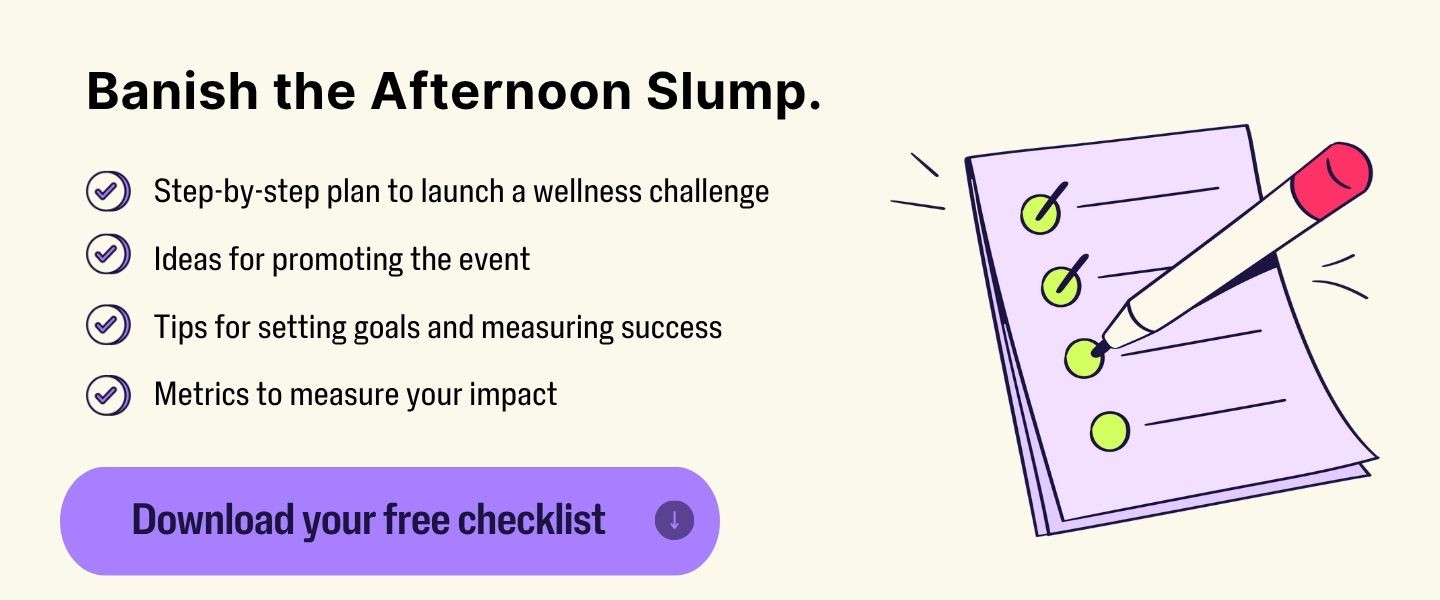
What You’ll Learn:
- A Clear Definition of Physical Wellness in the Workplace: A concise explanation you can share with teams and executives about what “physical wellness” means in a work context.
- Top 2025 Statistics on Wellness & Business Outcomes: Recent data-backed insights on how supporting employees’ physical health boosts productivity, lowers costs, and improves retention (with compelling stats CHROs can take to the C-suite).
- Strategies for a Successful Wellness Program: Six actionable tips for designing and implementing an effective physical wellness initiative – from gaining leadership buy-in to creating a culture of movement – with examples of what works.
- How to Measure ROI and Prove Impact: A breakdown of key metrics (surveys, participation, health outcomes, productivity, and cost savings) to evaluate your wellness program and demonstrate its value to stakeholders.
What is Physical Wellness in the Workplace?
Physical wellness in the workplace is an employee’s ability to maintain good physical health through movement, nutrition, sleep, and preventive care — all supported by the work environment.
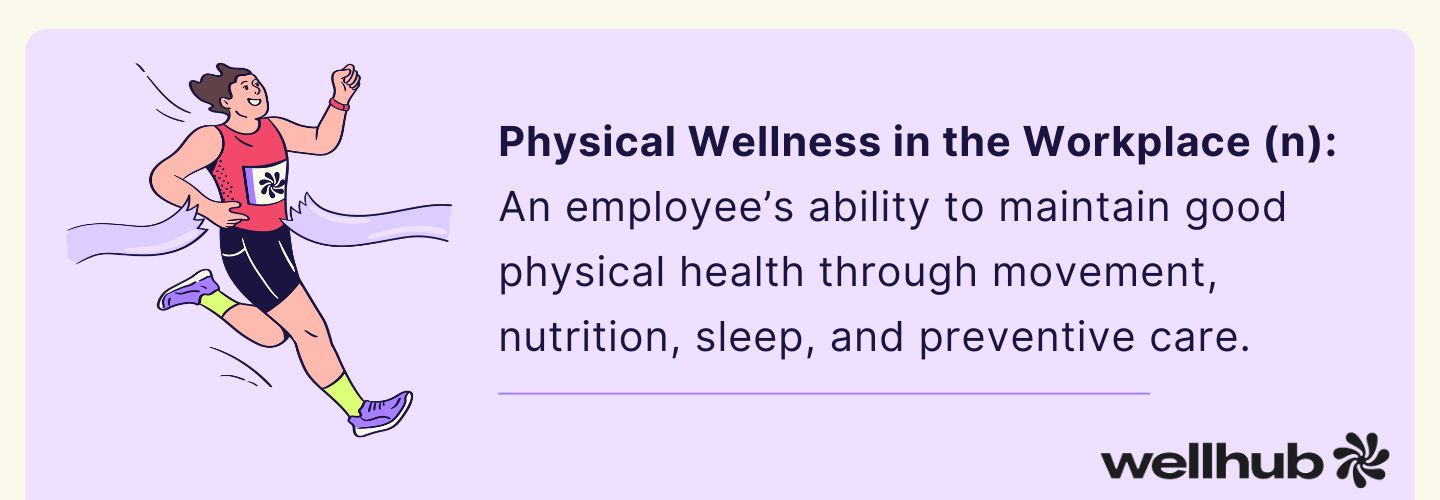
In practice, that might look like the company offering:
- Gym stipends or wellness app memberships
- Step challenges and hydration competitions
- Nutritious cafeteria or snack options
- Ergonomic workspaces with standing desks
- Preventive care like vaccinations and health screenings.
When organizations send the message that physical wellbeing matters, employees notice — and they respond. They feel cared for. They feel energized. They show up with more focus and less burnout.
This is more than good for morale — it’s good for business. According to the Return on Wellbeing 2025 report by Wellhub, 56% of CEOs say they invest in wellness programs to boost productivity, and 82% say those programs deliver a positive ROI.
When physical wellness becomes a shared workplace value, everyone benefits.
Dive deep into how workplace wellness can make your organization more successful.
Top Business Benefits of Prioritizing Physical Wellness (2025)
When your people feel good, they work better. It’s that simple.
But here’s the challenge for HR: 42% of U.S. adults are living with obesity, and healthcare costs keep rising — it’s expected to rise a full 10% next year alone. That means more stress, more sick days, and less energy to go around.
That’s where physical wellness programs come in. They help your team move more, rest well, and recharge. And the payoff? Happier employees, lower turnover, and real ROI.
- Improved Engagement & Morale: When employees feel cared for, they’re far more engaged. In fact, 67% of employees at companies with wellness programs say they like their jobs more and are more likely to recommend their employer. By contrast, only about 24% of workers overall strongly agree their organization cares about their wellbeing, a historic low that erodes morale. Prioritizing physical wellness sends a powerful message that the company values its people, lifting day-to-day enthusiasm and creating a workplace where people actually want to be.
- Reduced Healthcare Costs & Absenteeism: Employee illness and injury – often tied to physical inactivity or poor health – cost U.S. businesses billions each year in medical claims and lost days. Effective wellness programs help turn that tide. Roughly 9 in 10 HR leaders say their company’s healthcare costs decreased after implementing wellbeing initiatives (up from 78% a year prior)wellhub.com. Similarly, 89% of HR leaders have seen employees take fewer sick days once a wellness program is in placewellhub.com. Healthier employees mean lower insurance premiums, less absenteeism, and far fewer “out sick” emails clogging inboxes – all of which boost the bottom line.
- Enhanced Productivity & Performance: There’s a direct link between wellness and how well people perform on the job. When staff are healthy, well-rested, and not weighed down by aches or chronic issues, they can bring their A-game to work. It’s telling that 99% of HR leaders report that wellness programs increase employee productivity in their organization. On the flip side, when physical health issues and stress are ignored, burnout takes hold – and burnout is estimated to cost companies an astounding $322 billion annually in lost productivity. By addressing root causes of fatigue (think poor fitness, inadequate sleep, high stress), a physical wellness program helps employees stay focused, energized, and performing at their peak.
- Higher Retention & Talent Attraction: In today’s job market, employees vote with their feet – and they’re gravitating toward employers who value wellbeing. Nearly nine in 10 job seekers now consider an employer’s benefits package (including wellness offerings) when evaluating a new opportunity.. For younger generations especially, robust wellness programs are often a non-negotiable. Once on board, employees with wellness support are far less likely to quit. An overwhelming80% of CEOs say their wellness programs strengthen their company's ability to hire top talent. In fact, 42% say it is an "extremely impactful" part of talent attraction. The takeaway: a strong physical wellness program is a talent magnet that not only attracts high-caliber candidates but also keeps your best people sticking around.
- Stronger Organizational Culture & Resilience: A culture of wellness creates ripple effects across teamwork, loyalty, and even innovation. Wellness initiatives – from group step challenges and company sports teams to lunchtime walks and charity run fundraisers – build camaraderie and a sense of community. Employees who connect through healthy activities tend to feel a greater sense of belonging. In fact, companies that infuse recognition and social activities into their wellness programs see employees up to 10× more likely to feel they belong at the organization. By supporting employees as “whole humans” and celebrating healthy habits, organizations cultivate a positive culture where people feel valued and supported. This boosts overall resilience: teams that feel cared for can weather high-pressure periods or business challenges with far less friction. In short, emphasizing physical wellness doesn’t just create healthier employees – it helps build a healthier company climate, too.
With benefits like these, it’s no surprise that 82% of CEOs now report positive ROI from their wellness programs.
Physical wellness isn’t a cost center – it’s a catalyst for better business results.
Here’s how to find a whole-person wellness program that boosts performance.
17 Physical Wellness Program Initiatives and Ideas (Actionable Strategies for HR Leaders)
A strong physical wellness strategy doesn’t just help employees feel healthier—it improves productivity, retention, and overall culture.
Here’s how HR leaders can bring 17 effective ideas to life and why they make a difference.
On-Site & Virtual Fitness Opportunities
Why it works:Group classes build community and lower barriers to exercise by making it convenient.
How to activate: Partner with Wellhub to tap into a vast network of fitness partners—gyms, studios, and virtual classes—all in one subscription. Your team picks what fits them best and books it via the app.
Why it works: Cost is one of the biggest obstacles to consistent exercise. Subsidizing or covering a membership increases accessibility.
How to activate: Partner with Wellhub to get cost savings of up to 50% less than going direct—no negotiation needed on your end
Why it works: A physical space signals that wellness is a priority, while giving employees a place to recharge.
How to activate: Convert an underused room into a stretch, yoga, or meditation area, stocked with mats and quiet lighting. You can also use physical spaces with digital on‑demand classes via Wellhub to extend reach beyond office walls.
Why it works: Supports movement during the workday, especially for employees in sedentary roles.
How to activate: Provide printable guides, short videos, or lunch-and-learn sessions with physiotherapists.
Why it works: Flexibility is key for hybrid or global workforces. Apps allow employees to choose routines that fit their lifestyle.
How to activate: Offer enterprise access to an app with on-demand classes. Wellhub’s platform, for example, includes top-tier apps—like Apple Fitness+, Headspace, Strava—already integrated in one subscription.
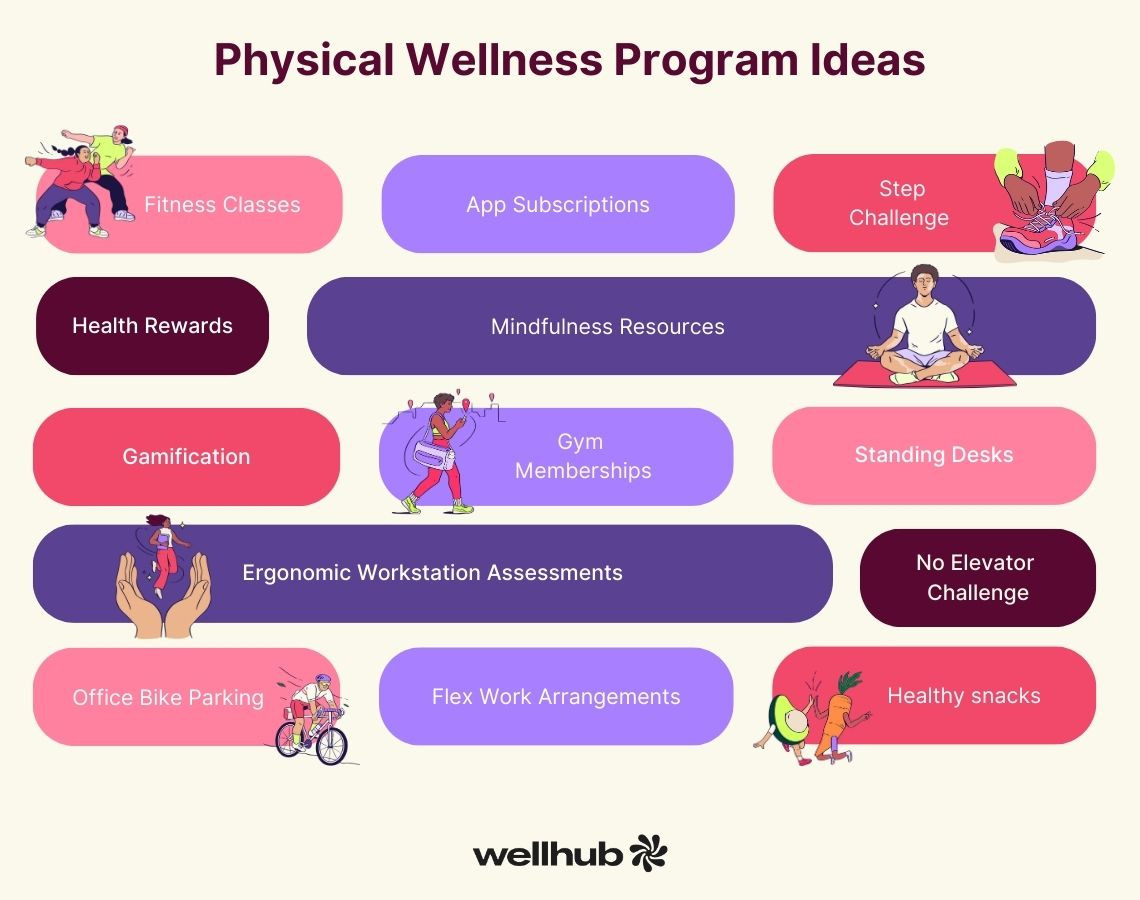
Engaging Activity Challenges & Incentives
Why it works: Gamified movement boosts accountability and creates camaraderie.
How to activate: Use a step-tracking app and organize teams to encourage friendly competition. With Wellhub, our built-in Challenges feature makes it easy to launch and invite teams to participate via the app.
Why it works: Incentives increase participation and show that wellness is valued.
How to activate: Align rewards with wellness—like spa vouchers, healthy meal kits, or additional rest days. This is easy with Wellhub, where admin tools can let you monitor engagement and reward top participants with internal incentives like PTO or gift cards.
Why it works: Points, badges, and leaderboards make wellness fun, increasing engagement rates.
How to activate: Introduce a digital wellness platform with built-in gamification, or create an internal leaderboard. Wellhub’s app includes gamified elements like badges embedded in the app.
Ergonomics & Optimizing the Work Environment
Why it works: Prevents long-term health issues like back pain and repetitive strain injuries.
How to activate: Bring in specialists to assess both office and remote setups, then provide tailored recommendations.
Why it works: Gives employees control over their posture, reducing sedentary strain.
How to activate: Start with a pilot program offering sit-stand desks or desk converters, and expand based on uptake.
Why it works: Frequent micro-breaks prevent fatigue and boost focus.
How to activate: Encourage managers to model “movement breaks,” and use reminders in calendars or collaboration tools.
Promoting Active Commuting & Facilities
Why it works: Active commuting improves cardiovascular health and reduces stress.
How to activate: Offer commuter stipends or wellness points for walking/cycling instead of driving. Wellhub’s expanding partner network—like Citi Bike in NYC—allows you to offer subsidized or included rides, while apps like Strava allow employees anywhere in the country to track their mileage.
Why it works: This commuting benefit eliminates logistical barriers to cycling or running to work.
How to activate: Add storage racks, lockers, and showers near entrances to support active commuters.
Keep your employees moving:
- 30 workplace wellness activities
- 17 plug-and-play physical wellness ideas
- 5 actionable employee fitness challenge ideas
- The Ultimate Guide to Workplace Wellness Challenges for HR Leaders
Fostering Nutrition & Healthy Eating Habits
Why it works: Small, everyday choices add up—healthy snacks prevent energy crashes.
How to activate: Replace high-sugar options with fruit, nuts, and low-sugar drinks. You can further amplify these choices through Wellhub’s nutrition content or partner apps like Lifesum—link to them in internal comms
Why it works: Builds knowledge and empowers employees to make sustainable changes.
How to activate: Bring in a registered dietitian for workshops and share resources in your HR portal.
Integrating Stress Management for Physical Health
Why it works: Stress impacts physical health, from blood pressure to sleep. Mindfulness tools help mitigate those effects.
How to activate: Provide company subscriptions to meditation apps, or host short daily guided sessions. Wellhub includes mindfulness and sleep apps like Headspace, available instantly via subscription, giving everyone the support they need.
Why it works: Burnout undermines physical health just as much as inactivity does. Supporting rest improves long-term productivity.
How to activate: Train managers to model healthy boundaries, track PTO usage, and remind employees to disconnect. Back these policies with Wellhub’s holistic wellbeing network—then reinforce them via regular reminders and leadership modeling. The broader wellness support makes balance feel more sustainable.
Strengthen workplace mental health:
- 7 proven strategies to strengthen emotional wellness at work
- Build psychological safety with these data-backed strategies
How to Get Leadership Support for a Physical Wellbeing Program
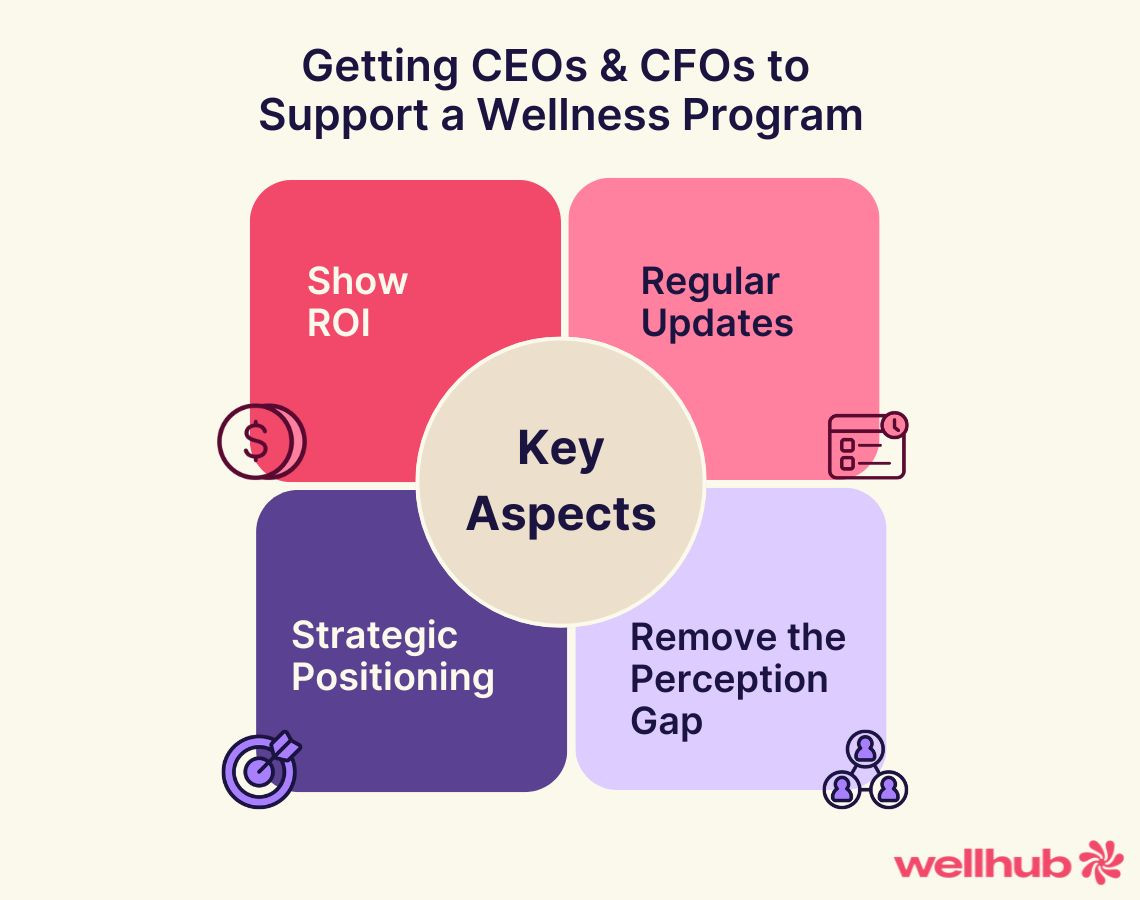
If you want leadership on your side, start by speaking their language: impact and ROI.
According to Wellhub’s original, international survey of more than 1,500 CEOs and business leaders, nearly 94% of CEOs have the final say on wellness budgets, so securing their buy-in is mission-critical. The good news? Leaders already believe in the connection between wellbeing and performance—58% strongly agree that wellbeing is critical to their organization’s financial success.
The challenge is making sure they see the value clearly and consistently.
Here’s how you can build that support step by step, based on the findings of Return on Wellbeing 2025: The CEO Edition.
Step 1: Show the ROI in Business Terms
Don’t just talk about healthier employees—tie wellness to measurable outcomes. CEOs are far more likely to boost budgets when they see results like reduced absenteeism, higher productivity, and lower turnover. In fact, 82% of CEOs across industries report a positive ROI from their wellness program. Use data to connect wellbeing directly to productivity, healthcare savings, and retention.
Step 2: Provide Regular Impact Updates
Consistency matters. CEOs who receive monthly wellness impact updates were 58% more likely to increase funding last year. Create a rhythm of reporting that highlights both employee outcomes and bottom-line savings. A one-page monthly dashboard with metrics like absenteeism reductions or engagement boosts can go a long way.
Nail your pitch with 22 ways to overcome C-suite objections to wellness programs.
Step 3: Position Wellness as a Strategic Asset
Frame wellness not as a perk, but as preventive healthcare and a driver of performance. Two-thirds of CEOs in the survey believe employees would consider leaving if wellbeing isn’t prioritized. Making that case aligns wellness with retention and employer branding goals—issues every leader cares deeply about.
Step 4: Close the Perception Gap
The global survey also revealed that CEOs often think their wellness strategies are working better than employees feel they are. Bring employee feedback to the table to highlight real experiences and needs. This helps leadership see beyond surface-level perceptions and recognize where deeper investment is needed.
Bottom line: When HR leaders combine data, storytelling, and steady reporting, they make the business case for wellness undeniable. That’s when leadership shifts from “approving budgets” to becoming champions of wellbeing.
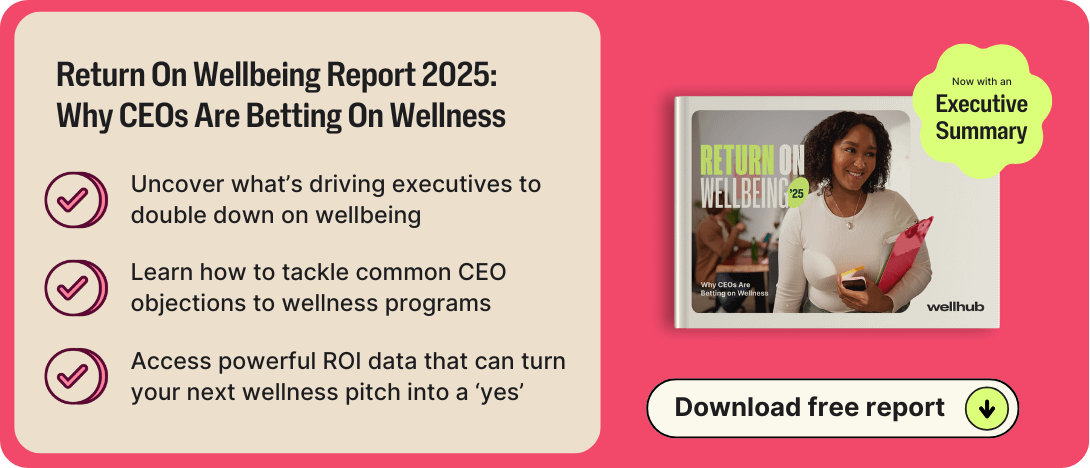
6 Tips for Facilitating a Successful Physical Wellness Program
Implementing a wellness initiative requires more than a budget line and good intentions – it takes thoughtful strategy to truly succeed. Here are six proven strategies for HR leaders to facilitate a thriving physical wellness program in the workplace. These tips will help you boost participation, sustain engagement, and maximize the impact of your wellness investments (with examples of how to put each strategy into action):
- Offer Flexible, Inclusive Wellness Options
One of the biggest hurdles to employee wellness is lack of time. In fact, lack of time is the top barrier keeping over 56% of employees from exercising regularly.
To overcome this, meet employees where they are. Provide flexible wellness offerings that can fit into busy schedules and diverse lifestyles. Examples to consider include: Offering multiple formats for physical activity — from on-site yoga classes at lunch — or free app-based fitness memberships employees can use anytime, or simple “walk at work” breaks. Consider partnering with a wellness provider like Wellhub allows employees to work out in person or virtually wherever they’re based. By giving options (in-person, virtual, during or outside work hours), you remove obstacles and empower more employees to participate.
- Secure Leadership Buy-In and Participation
Visible executive support can make or break your wellness program. When the C-suite and managers actively champion wellness, employees know it’s truly valued (not just lip service).
Even more importantly, leaders who lead by example set a cultural norm for prioritizing health. Companies where over 70% of senior leaders engage in the wellness program enjoy employee participation rates nearing 80%, compared to around 44% participation when leadership involvement is low. Consider asking executives to publicly commit to wellness goals (like the CEO sharing that she’s training for a 5K or a step challenge). Invite leaders to kick off wellness events or attend fitness classes alongside employees. When the budget allows, have leadership announce meaningful wellness investments (new wellness challenges, healthier cafeteria menus, etc.). This top-down support lends credibility and encourages managers and employees alike to prioritize wellness in their day.
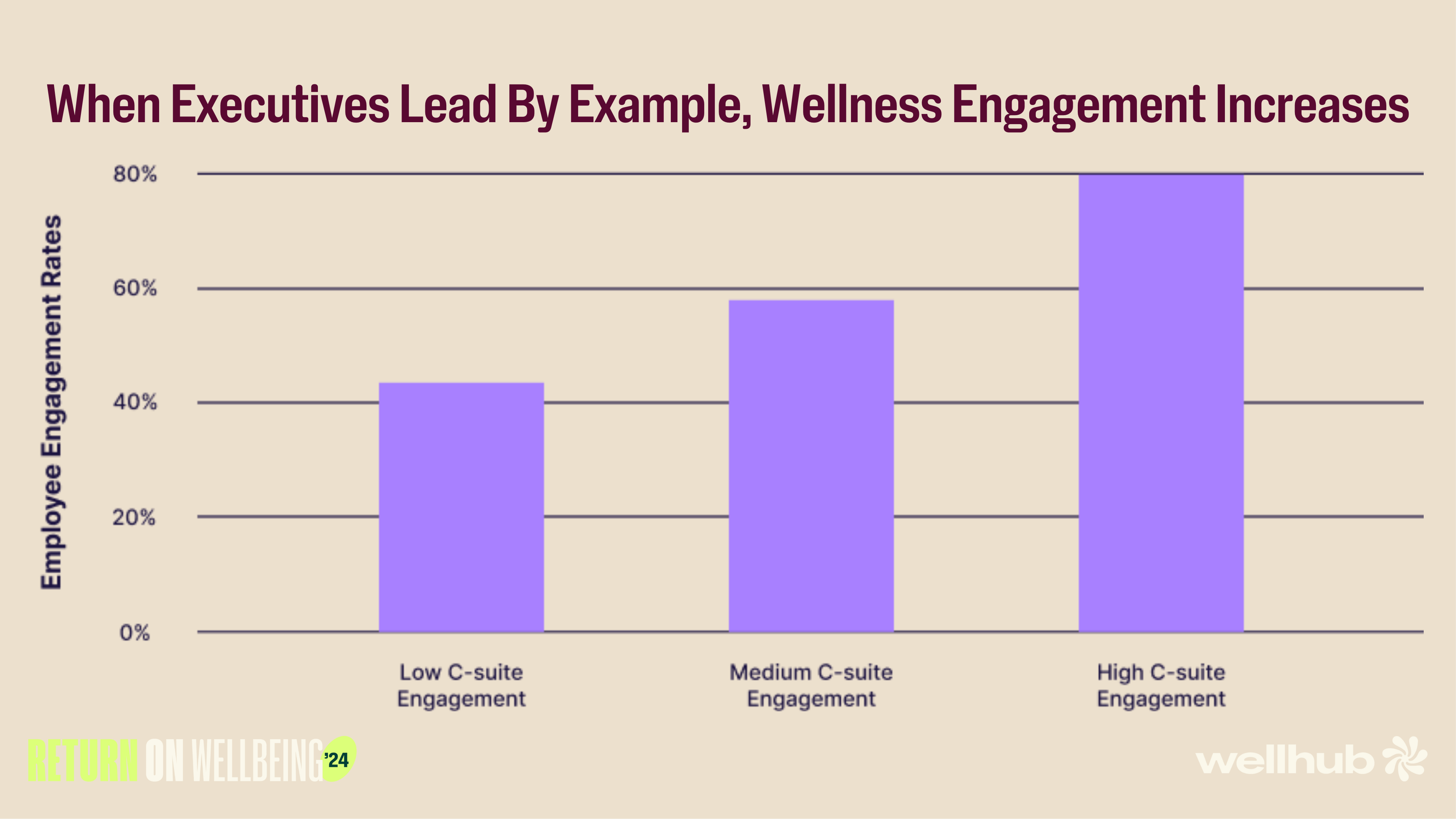
- Personalize Programs to Employee Needs
A one-size-fits-all approach won’t maximize engagement – your workforce likely spans various ages, abilities, and interests. Some employees might be avid cyclists or runners, others may prefer meditation or nutrition coaching.
To design a program people will actually use, listen to your employees’ needs. Use surveys or focus groups to identify which wellness activities employees care about most (e.g. weight management, marathon training, yoga, smoking cessation). Offer a menu of wellness benefits so employees can choose what fits their health goals – for instance, one employee might opt for a subsidized gym membership while another uses a stipend for healthy meal deliveries. You can also tailor initiatives by department or demographics: young professionals might appreciate fitness class passes, while workers with children might value a flexible schedule to attend medical appointments or family health events. Personalization shows that the program is truly for them, increasing uptake and satisfaction.
- Create a Culture of Movement and Healthy Habits
Make wellness part of the fabric of the workday, not an afterthought. Small changes to the work environment and routines can encourage employees to be more active day-to-day.
For example, you can introduce “movement breaks” – encourage teams to do walking meetings or stretch for five minutes during long meetings. Provide accessible facilities like bike racks, showers, or standing desk options to make activity easier. You can also start an inter-department steps challenge with fun prizes, or organize volunteer-led group workouts (a morning jogging club, a post-work sports game, etc.). Even offering healthy snacks in the breakroom (think fruit, nuts, yogurt) instead of just donuts can reinforce healthy choices.
These initiatives signal that it’s not only okay but encouraged to integrate wellness into the workday. Over time, healthy habits like taking the stairs, staying hydrated, or doing quick stretches become second nature – boosting employees’ energy and reducing the mid-day slumps. (It also helps address fitness gaps – currently, only about 54% of employees consider themselves in “good shape,” meaning nearly half feel out of shape. Building movement into work can help close that gap.)
We made it easy: Launch your wellness program with this step-by-step guide.
- Communicate, Educate, and Encourage Continuously
Launching a wellness program with fanfare is great – but ongoing communication and support are what keep it alive. Make sure employees know what resources are available and feel comfortable using them. Normalize conversations about health at work to reduce stigma.
To bring this to life, train managers on how to talk about wellbeing in check-ins (e.g. encouraging their team to take PTO or use wellness days). Share success stories: if an employee achieved a personal health goal with help from the program, feature it (with permission) in an internal newsletter to inspire others. Maintain a steady drumbeat of promotion for wellness activities – posters about upcoming wellness challenges, quick “did you know?” emails about new wellness app features, reminders during all-hands meetings about available programs.
Also, educate employees on how to utilize benefits (for instance, how to book a free session with a nutritionist or access the meditation app subscription). The easier and more accepted it is to engage in wellness at work, the more your program will thrive. Over time, you want a workplace where taking a walking break or scheduling a preventative screening is seen as a smart work habit, not a guilty break.
- Measure Results and Share Success Stories
To sustain support (and funding) for your wellness initiatives, measure their impact and report it. Tracking results not only helps you prove ROI; it also lets you continuously improve the program. (We’ll dive deeper into metrics in the next section.)
Define a set of key performance indicators (KPIs) for your wellness program from the start – such as participation rate, average monthly gym visits per employee, reduction in sick days, or changes in aggregate health risk factors. Use simple dashboards to monitor these. Then close the loop by informing leadership (and employees) of the positive outcomes. For instance, you might report to the executive team that 70% of eligible employees are now active in the wellness platform, and quarterly health screenings showed a 15% improvement in average blood pressure readings across the company.
Sharing wins helps maintain enthusiasm. It certainly catches executives’ attention – CEOs care about these numbers: 58% of CEOs who are updated on the impact of their wellness program at least once a month significantly increased funding for their wellness program last year. When leadership sees hard data (like lower healthcare claims or higher productivity metrics), they’re more likely to increase funding and champion the program further. Bottom line: track it, prove it, promote it.
Measuring Success: Proving ROI of Physical Wellness Programs
How do you know if your wellness efforts are actually making a difference?
A comprehensive evaluation plan is essential – both to improve the program over time and to demonstrate its value to skeptics or budget-holders. The impact of a physical wellness program can be seen across multiple dimensions, so a mix of metrics will give the fullest picture.
Here are five key categories of metrics to measure the success of your wellness program and prove the ROI to stakeholders:
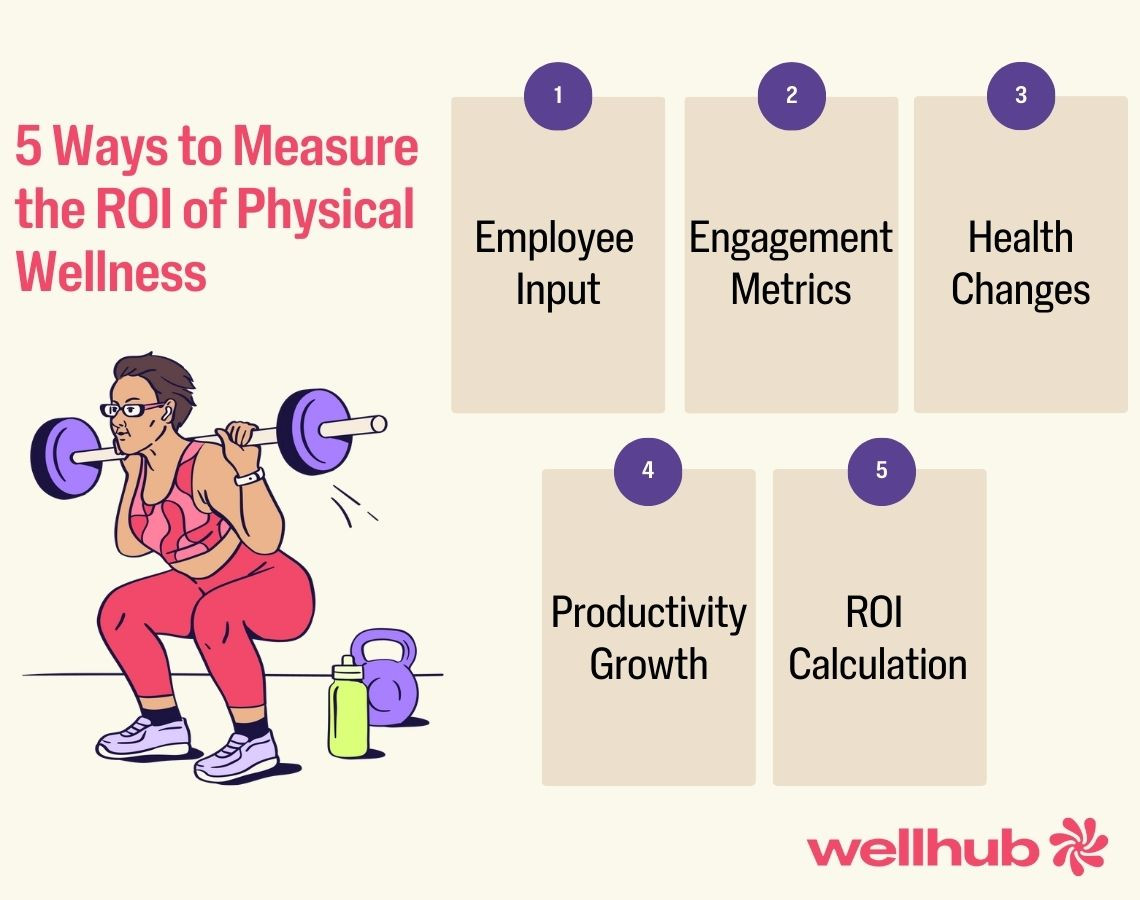
1. Employee Surveys & Qualitative Feedback: Listen to your employees
Surveys and feedback tools can capture changes in employee attitudes that hard numbers might miss. Regular wellness surveys (or sections in your employee engagement survey) can gauge how employees feel about the program and its effects. Are employees reporting lower stress levels or higher job satisfaction since the program began? Do they feel the company cares about their wellbeing?
For example, you might find through surveys that overall self-reported stress is down 20% year-over-year after introducing a fitness and mindfulness initiative. Also collect qualitative anecdotes – success stories or testimonials – such as an employee sharing that they have more energy and fewer back pains thanks to the new ergonomics workshop. These narratives put a human face on your metrics and can be very powerful for winning support from senior leaders (“Our call center rep Mark says he’s lost 20 lbs. and has much more stamina on shift after joining our wellness challenge…”).
Don’t forget to measure awareness and satisfaction with the program itself – ask if employees know about the offerings and find them valuable. High satisfaction ratings and positive comments indicate the program is resonating, which is an early sign of success.
- Participation Rates & Engagement Metrics: Track the numbers on who is using what.
Participation is the foundational metric for any wellness program – if people aren’t participating, it can’t create outcomes. Measure the percentage of employees engaging in various wellness offerings: How many employees attend at least one fitness class or use the wellness app each month? What portion have completed a health risk assessment or annual biometric screening?
Aim for a strong uptake – many experts consider 50% participation a good initial benchmark for wellness programs, with higher as a stretch goal. Break it down by activity to see which offerings are most popular (e.g. step challenge participation vs. flu shot clinic turnout).
Engagement depth is also key: track frequency of use (are employees regularly going to the gym or was it just a New Year’s spike?) and sustained involvement over time. If you have a platform that logs usage, you can report metrics like “Total wellness platform logins this quarter” or “Average number of workouts per active user.” These metrics show whether the program is becoming part of employees’ routines.
A climbing participation rate, or even maintaining high participation as your company grows, is a clear indicator of success. On the flip side, if participation is low or drops off, it flags a need to reassess your communications or offerings.

- Productivity & Morale Indicators: Link wellness to workplace performance.
While harder to attribute directly, improvements in employees’ physical wellness should show up in metrics related to productivity, engagement, and morale. Key indicators to watch include absenteeism (track the average number of sick days taken per employee per year – a drop is a positive sign) and presenteeism (productivity lost when employees are at work but not fully functioning due to health issues – often measured via survey or assessment). If your employee engagement surveys include items like “I would recommend my company as a great place to work” or “I have the energy to do my best every day,” monitor those scores for improvement.
You might also look at the employee Net Promoter Score (eNPS) and overall job satisfaction ratings – wellness can influence these by making employees feel more valued and supported. Gallup research shows that employees who feel their employer cares about their wellbeing are more than 4 times as likely to be engaged at work and 73% less likely to experience burnout. So, if your physical wellness program is effective, you’d expect to see higher engagement scores and lower reports of burnout over time.
Another key metric: turnover rates, especially voluntary resignations. We know wellness programs can improve retention (as noted, HR leaders report significant drops in turnover due to wellness). Track your retention and see if it improves after implementing wellness initiatives – for example, perhaps your annual voluntary turnover fell from 15% to 10%, saving you considerable replacement costs. While many factors influence retention and productivity, being able to correlate improvements with the timing of your wellness program provides a strong narrative of its value.
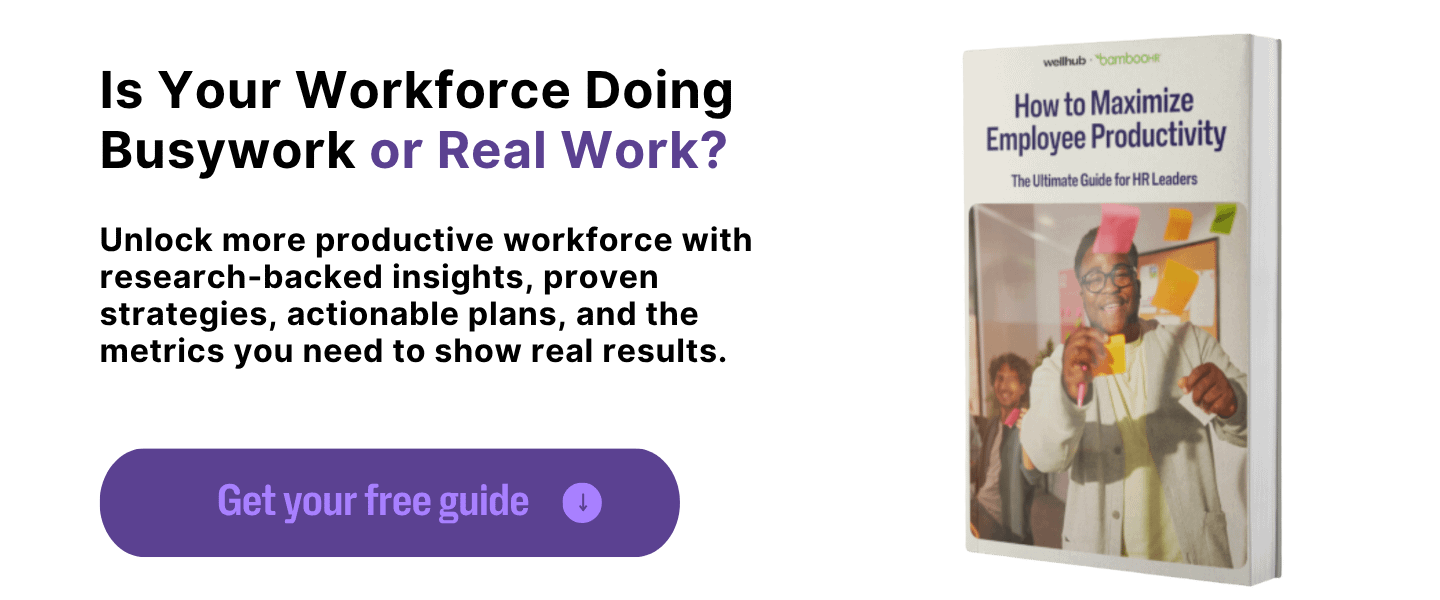
- Health Metrics (Aggregate & Anonymous): Measure actual health outcomes in aggregate, to protect privacy.
One ultimate goal of a physical wellness program is to improve employees’ health indicators, which can translate to lower health risks and costs. Companies working with Wellhub, for example, saved $200 million in reductions in healthcare costs in 2023 alone.
Work with your wellness vendors or health insurance provider to gather anonymous, aggregated health data for your population. For example, you might look at changes in average BMI, blood pressure, or cholesterol levels from year to year (if your program offers screenings or uses health assessment tools). Track metrics like the percentage of employees in high-risk categories (for blood pressure, glucose, BMI, etc.) and see if those percentages decline over time.
Another useful metric is healthcare utilization rates, such as how many employees are getting annual physicals or age-appropriate screenings (a wellness program often encourages preventive care). If you run specific interventions – say a weight management program – measure the total weight lost by participants or the percentage who achieved a 5% body weight reduction. Additionally, consider injury rates or workers’ comp claims if relevant – a more physically fit workforce might experience fewer musculoskeletal injuries on the job.
By presenting data like “Our employees’ average number of steps per day increased 20% this year” or “The share of employees with ‘ideal’ blood pressure went from 60% to 75% since we started our wellness program,” you directly connect the program to tangible health improvements.
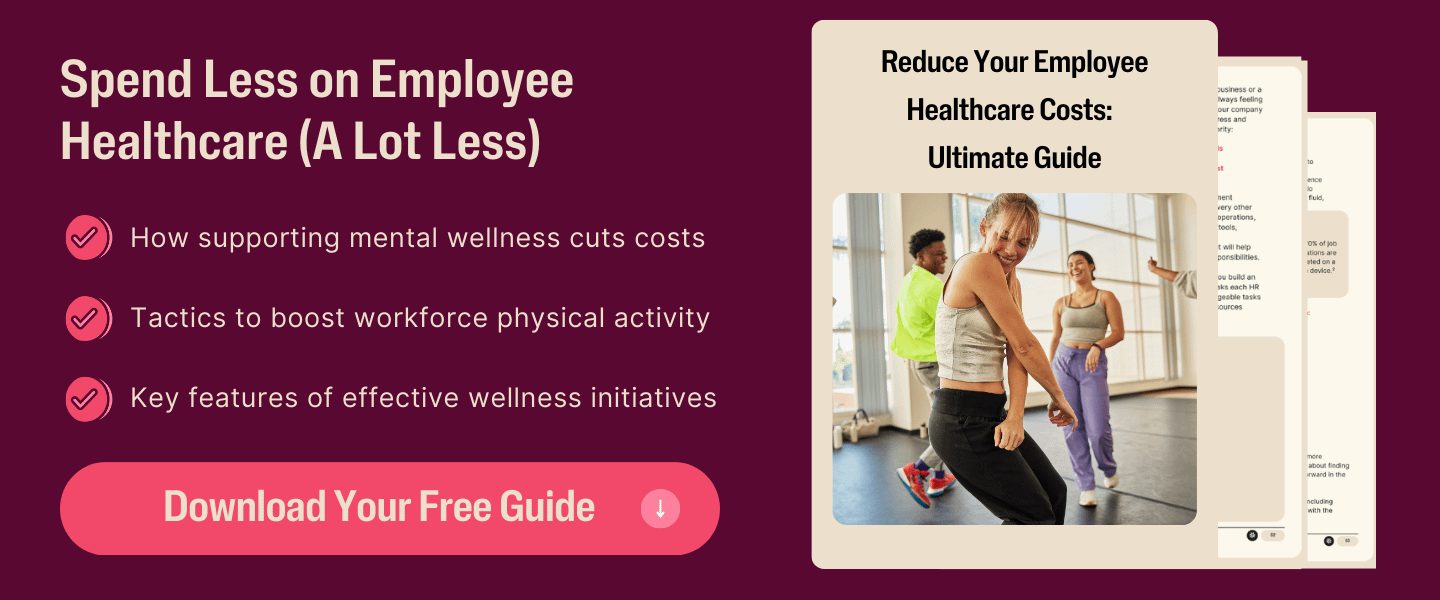
- Cost-Benefit Analysis & ROI Calculation: Show the financial return
To satisfy your CFO or simply justify the budget, you’ll eventually need to translate wellness outcomes into dollars.
Start by totaling the costs of your program: vendor fees, wellness staff time, incentives paid out, etc. Then calculate the savings/benefits: this can include hard dollar savings like reduced healthcare claims, lower disability or workers’ comp costs, and decreased recruitment costs due to better retention. For instance, if your insurer provides data, you might find that your company’s healthcare cost trend went up only 2% this year, compared to 6% for similar firms – and attribute that difference to wellness efforts. Quantify the value of reduced sick days (e.g. X fewer sick days saved an estimated $Y in lost productivity) and reduced turnover (each retained employee saves recruiting and training costs).
Many companies use a simple ROI formula:
![Formula image showing Wellness Program ROI as [(Total Savings - Program Cost) / Program Cost] x 100.](https://assets-cdn.wellhub.com/images/mep-cms/how_to_return_from_physical_wellness_program_c58bfc521b.jpg)
If you spent $100,000 on wellness and estimate $200,000 saved (through healthcare and productivity gains), that’s a 100% ROI or a 2:1 return. And that’s not a far-fetched number. In fact, a well-known Harvard study found that on average, comprehensive wellness programs return about $2.7 in improved health and productivity for every $1 spent.
Your own ROI may vary, but even showing a positive trend is impactful. Also consider measuring VOI (Value on Investment) – the less tangible benefits like improved company culture or employee happiness which might not show up immediately in dollars but are strategically important. Presenting a robust cost-benefit analysis – for example, “In the two years since we launched the wellness program, we’ve saved an estimated $300,000 in health-related costs, a 150% return on our investment” – is often the clincher that turns skeptics into supporters.
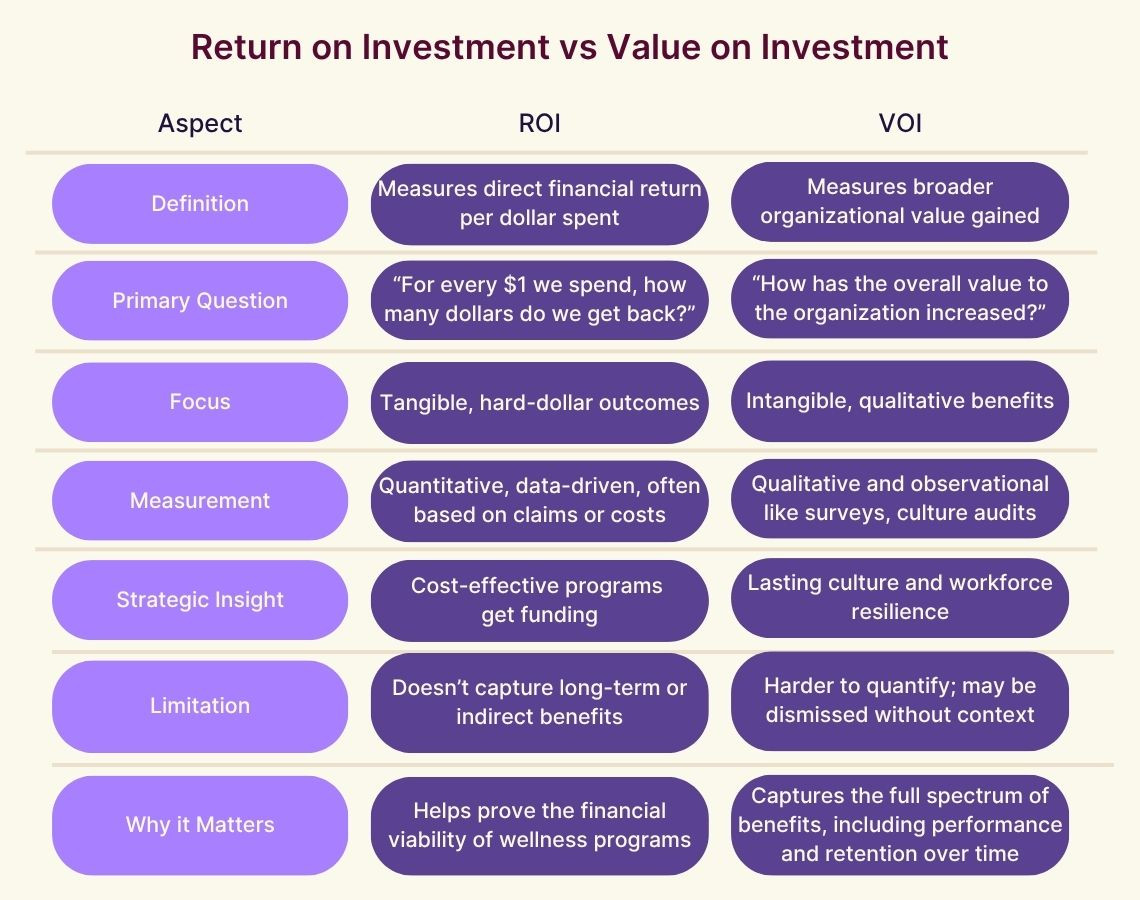
By combining data from all five categories above, you create a compelling, 360° view of your physical wellness program’s impact. It’s this combination of human stories and hard statistics that will help you continuously improve your program and secure buy-in from stakeholders at all levels.
Launch a wellness program that lifts engagement and lowers costs.
Physical Wellness Fuels People—and Performance
Many HR leaders struggle with rising healthcare costs, growing burnout, and low engagement. Physical wellness often sits at the heart of these issues. When employees feel sluggish, stressed, or unsupported in their health, productivity drops and turnover climbs.
A strong physical wellness program tackles those problems head-on. It helps employees move more, sleep better, and recharge often. The impact is real: 89% of HR leaders have seen fewer sick days and 82% of CEOs report a positive ROI from their wellness investments. Healthier teams mean fewer disruptions, more focus, and stronger morale—plus a workplace culture people want to be part of.
Speak with a Wellhub Wellbeing Specialist to build a physical wellness program that lowers healthcare costs, boosts energy, and keeps top talent engaged.

Company healthcare costs drop by up to 35% with Wellhub*
See how we can help you reduce your healthcare spending.
[*] Based on proprietary research comparing healthcare costs of active Wellhub users to non-users.
Category
Share

The Wellhub Editorial Team empowers HR leaders to support worker wellbeing. Our original research, trend analyses, and helpful how-tos provide the tools they need to improve workforce wellness in today's fast-shifting professional landscape.
Subscribe
Our weekly newsletter is your source of education and inspiration to help you create a corporate wellness program that actually matters.
Subscribe
Our weekly newsletter is your source of education and inspiration to help you create a corporate wellness program that actually matters.
You May Also Like

FSA vs. HSA Strategy for HR Leaders | Wellhub
Compare FSA vs HSA rules, tax advantages, eligibility, and rollover differences to help employees choose the right account and avoid costly compliance issues.

Employee Wellness Programs: Key Components for Success | Wellhub
Transform your workplace wellness strategy by integrating physical, mental, financial, and social wellbeing into a comprehensive wellness program that works

Benefits Strategy Roadmap: Pull and Retain Top Talent | Wellhub
Support wellbeing, reduce turnover, and maximize ROI with a benefits strategy built for today’s workforce—not yesterday’s spreadsheet.